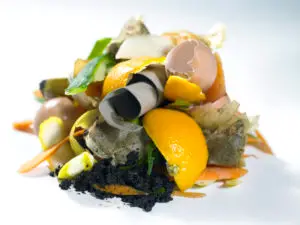Bokashi Composting: The Ultimate Guide to Indoor Composting at Home
Learn how to start Bokashi composting at home with our complete guide. Perfect for apartments and small spaces, Bokashi bins let you compost meat, dairy, and cooked food while creating fertiliser for your plants.

If you want to reduce food waste but don’t have the space for a garden compost heap, Bokashi composting could be your perfect solution. Compact, fast, and almost odour-free, this method allows you to compost indoors—even in small apartments. Best of all, unlike traditional composting, Bokashi can handle meat, dairy, bread, and cooked leftovers, making it one of the most versatile composting methods available.
In this complete guide, we’ll explain what Bokashi composting is, how it works, what you need to get started, and how to use your finished Bokashi pre-compost in your garden or community space.
What Is Bokashi Composting?
Bokashi composting is a method of indoor composting that uses fermentation instead of decomposition. Food scraps are placed in a sealed bucket and covered with Bokashi bran—a mix of wheat or rice bran inoculated with beneficial microbes such as lactic acid bacteria and yeast.
After 2–4 weeks, the scraps become a fermented mixture called Bokashi pre-compost. This is then buried in soil, added to a compost heap, or placed in large pots to fully break down into rich organic matter.
The word Bokashi is Japanese for “fermented organic matter,” highlighting its origins in Japan, where this technique has been used for decades.
Why Try Bokashi Composting?
More people are turning to Bokashi as a practical solution for food waste. Here’s why:
Indoor-friendly: The airtight Bokashi bin prevents odours, making it ideal for apartments.
Works with all foods: Meat, fish, dairy, bread, and cooked meals can all go in.
Fast results: Pre-compost is ready in just 2–4 weeks.
Produces liquid fertiliser: Known as Bokashi tea, this by-product is a powerful plant booster.
Low effort: No need to balance greens and browns or turn the pile.
For Australians looking for indoor composting solutions, Bokashi is one of the easiest and most sustainable options.
What You Need for Bokashi Composting
To set up a Bokashi system at home, you’ll need:
A Bokashi bin: A sealed bucket with a tap to drain liquid. Many kits are sold online in Australia, or you can DIY with a food-grade bucket and spigot.
Bokashi bran: Available at garden centres or online, this is essential for fermentation.
Food scraps: Almost all kitchen waste can go in, unlike traditional composting.
A final resting place: A garden bed, compost heap, or large planter to finish the breakdown stage.
Tip: Most people buy two bins so one can ferment while the other is being filled.
Step-by-Step: How to Use a Bokashi Bin
Add scraps: Place chopped food waste into the bin.
Sprinkle Bokashi bran: Add a light handful over each layer.
Press down: Use a plate or press to remove air.
Seal tightly: Keep the environment anaerobic (airless).
Drain liquid: Every few days, collect the Bokashi tea.
Fill and rest: When full, let the sealed bin sit for 2 weeks.
Bury or compost: Transfer the pre-compost to soil or a heap.
What Can You Put in a Bokashi Bin?
Yes:
Fruit and vegetable scraps
Meat, fish, and bones (small pieces)
Dairy products (cheese, yoghurt, milk)
Bread, rice, pasta, grains
Cooked food and leftovers
Coffee grounds and tea bags
Avoid:
Excess liquid (soups, oils, alcohol)
Large bones
Garden waste, leaves, cardboard
How to Use Bokashi Pre-Compost
After fermentation, your scraps will look pickled and may have a vinegar smell with white mould (a sign of healthy microbes). You can:
Bury in the garden: Dig 20–25 cm deep, add pre-compost, and cover with soil.
Add to a compost bin: Speeds up traditional composting.
Use in pots: Add to a large planter and top with soil. Wait 2–3 weeks before planting.
Bokashi Tea: Liquid Gold for Your Plants
One of the best parts of Bokashi composting is the Bokashi tea. This liquid fertiliser collects at the bottom of the bin and should be drained every few days.
For plants: Dilute 1 teaspoon per litre of water before use.
For drains: Pour undiluted into sinks and drains to keep pipes fresh.
Use within 24–48 hours, as the microbes are most active when fresh.
Troubleshooting Common Problems
Bad odour (rotten smell): Too much liquid, not enough bran, or lid not sealed. Solution: add bran, drain liquid, press scraps down.
Green/black mould: Wrong microbes—discard and restart.
White mould: Perfectly healthy! Keep going.
Bin filling too fast: Chop scraps smaller or use two bins.
Bokashi vs Traditional Composting
| Feature | Bokashi Composting (Indoor) | Traditional Composting (Outdoor) |
|---|---|---|
| What it accepts | Meat, dairy, cooked food, grains | Mostly fruit, veg, garden waste |
| Where it works | Indoors, apartments, small spaces | Gardens, backyards |
| Timeframe | 2–4 weeks fermentation + soil stage | 3–12 months decomposition |
| Effort | Low (just add bran + drain liquid) | Medium (turning, balancing mix) |
| By-products | Bokashi pre-compost + liquid tea | Finished compost |
Bokashi Composting in Australia
Bokashi composting is growing quickly across Australian cities, especially where backyard space is limited. Many councils now encourage residents to try it as part of food waste reduction programs. If you don’t have a garden, you can:
Check for community composting hubs in Melbourne, Sydney, Brisbane, and other cities.
Ask local community gardens if they accept Bokashi pre-compost.
Use a large outdoor pot filled with soil as your mini “burying” spot.
Sustainability Benefits of Bokashi
Keeps food waste out of landfill.
Reduces methane emissions.
Returns nutrients to soil naturally.
Encourages sustainable living, even in apartments.
Final Thoughts
Bokashi composting is one of the easiest ways to reduce food waste at home. It’s simple, clean, and works in small spaces where traditional composting isn’t practical. With just a bucket, some Bokashi bran, and your kitchen scraps, you can create a system that transforms food waste into valuable soil nutrition.
Whether you’re in a city apartment or a suburban home, Bokashi makes it possible to compost almost everything you eat—and that’s a big win for both your household and the planet.
